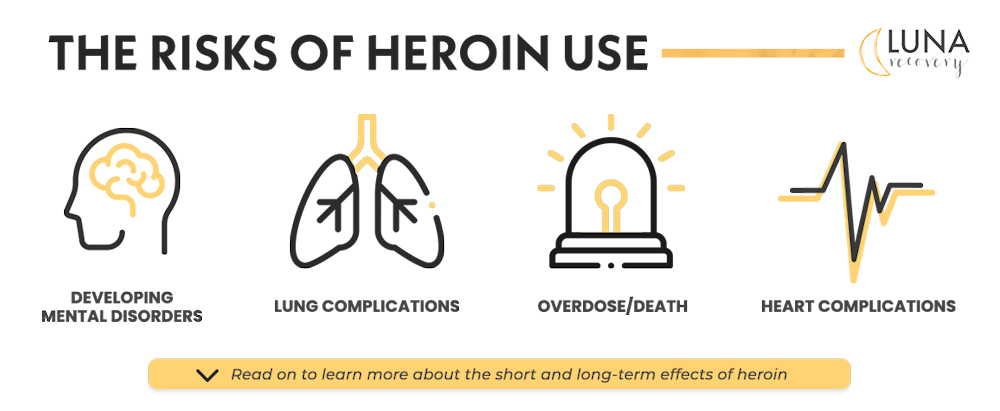Heroin Addiction Treatment in Houston, Texas
What Is Heroin?
Heroin is an opioid drug that is composed of morphine, which is a natural substance that is taken from the seed pod of several opium poppy plants grown in Mexico, Colombia, Southwest, and Southeast Asia. It can be a brown or white powder, or even a black sticky substance that is known as black tar heroin. Pure heroin use has a bitter taste that is abused for euphoric effects.
The common opiates available that are available by prescription include the following:
- Hydromorphone
- Oxymorphone
- Hydrocodone
- Methadone
- Oxycodone
- Tapentadol
- Morphine
- Tramadol
- Fentanyl
- Codeine
Most of the agents are classified by the DEA as Schedule II narcotics. Heroin is classified under the Controlled Substances of 1970 as a Schedule I drug. It carries rigid criminal penalities and has no tolerable medical use in the U.S.
In November 2020, the state of Oregon was voted on Measure 110 to allow the use of drugs, including heroin. The law doesn’t legalize all the drugs, it means the state will remove criminal prison time for possession of small amounts of illegal drugs and criminal penalties. Instead, this involves a $100 fine or even a “completed health assessment” at an addiction recovery center. The sale of drugs such as cocaine and heroin will still be illegal.
Heroin on the street common names:
- Brown Sugar
- White Horse
- China White
- Black Tar
- Thunder
- Big H
- Smack
- Skunk
- Chiva
- Junk
- Skag

How Addictive Is Heroin?
Since heroin is derived from the morphine alkaloid that is found in the opium poppy plant, it’s 2-3 times more addictive than morphine. Typically, it’s smoked, injected, or snorted up a person’s nose. Heroin contributes pain-relieving and anti-anxiety properties and provides feelings of euphoria, which makes this drug appealing to users.
Heroin is an illicit drug sold as a brownish or white powder and typically “cut” with several other drugs or substances such as starch, powdered milk, sugar, or quinine. Heroin can also be cut with poisons such as strychnine. This form of heroin is injected.
Potent opioids like fentanyl and carfentanyl have been discovered cut into heroin and accessed on the streets. It can be deadly to the unsuspecting user. Another form is known as “black tar” which can be sticky such as roofing tar, or even hard such as coal. The color might vary from dark brown to black. Usually, this form is snorted or smoked.

Effects of Heroin Use
Heroin enters a person’s brain quickly and binds to opioid receptors once cells are located in several areas. Especially those involved in feelings of pleasure and pain and in controlling sleeping, breathing, and heart rate.
Short-Term Effects of Heroin Use
Individuals who use heroin report experiencing a “rush” (euphoria or a surge of pleasure). However, the other common effects include:
- Going “on the nod”, which is a back-and-forth state of semiconsciousness and consciousness
- Heavy feeling in the legs and arms
- Clouded mental functioning
- Warm flushing of the skin
- Nausea and vomiting
- Severe itching
- Dry mouth
Long-Term Effects of Heroin Use
Individuals who engage in Heroin use over a long-term period might develop the following:
- Mental disorders such as anxiety personality disorder and depression
- Damaged tissue inside the nose for people who snort or sniff it
- Collapsed veins for people who inject the drug
- Abscesses (swollen tissue filled with pus)
- Lung complications, including pneumonia
- Infection of the valves and heart lining
- Irregular menstrual cycles for women
- Stomach cramping and constipation
- Sexual dysfunction for men
- Kidney and liver disease
- Insomnia

Signs and Symptoms of Heroin Addiction
The signs and symptoms of heroin addiction will greatly vary among individuals based on:
- The dependency on the drug
- Amount of drug used
- Frequency of use
- Genetic makeup
Most common signs and symptoms of heroin addiction:
- Possession of needles, syringes, glass pipes, missing shoelaces, and burned spoons
- Stashing drugs in several places around the car, work, and home
- Periods of hyperactivity followed by periods of exhaustion
- Wearing long shirts and pants, even in warm weather
- A decline in academic and occupational performance
- An inability to fulfill responsibilities at school or work
- Bruises and scabs as the result of picking at skin
- Decreased attention to personal hygiene
- Track marks on legs and arms
- Lack of motivation and apathy
- Frequent respiratory infections
- Pressured, forced speech
- Depression and anxiety
- Hostility toward others
- Irritability and agitation
- Shortness of breath
- Warm, flushed skin
- Increased sleeping
- Constricted pupils
- Extreme itching
- Slurred speech
- Mood swings
- Euphoria
Heroin Addiction Statistics
Heroin was synthesized first legally from morphine (which came from opium) in the late 1800s. In the United States, the Bayer Company of Germany was the first to introduce heroin in the United States. However, by the early 1900s, abuse and addiction were widespread.
By 1924, the federal law made heroin use illegal in the U.S. In the United States, opium is hardly grown and cultivated, but it’s brought in from several Latin American countries. The capital of opium harvesting is Afghanistan, and it roughly produces 75% of the world’s heroin supply.
Why Is Heroin So Addictive?
Heroin is so addictive because of several reasons. Individuals who engage in regular use of heroin will develop a tolerance often and this means they will need higher, and/or more recurring doses of the drug to get the desired effects. A substance use disorder (SUD) occurs when continued use of the drug can cause issues such as the following:
- Failure to meet responsibilities at school, work, or home
- Health problems
A person’s SUD can range from mild to severe, and the most severe form is addiction. Individuals who are addicted to heroin and stop using the drug rapidly might experience severe withdrawal. The withdrawal symptoms can start as early as a couple of hours after the drug was taken and include:
- Unmanageable leg movements (“kicking the habit”)
- Cold flashes with goosebumps (“cold turkey”)
- Severe bone and muscle pain
- Severe heroin cravings
- Diarrhea and vomiting
- Restlessness
Overall, researchers are studying the long-term effects that opioid addiction has on a person’s brain. Studies have shown some loss of a person’s brain matter that is associated with heroin use. This might affect decision-making, responses to demanding situations, and behavior control.
Risks of Overdose With Heroin
Since heroin is a highly addictive and illegal opioid drug, an overdose can cause shallow and slow breathing, coma, or death. Individuals who often use heroin along with several other drugs or alcohol engage in a very dangerous practice that can increase the risk of overdose. Typically, heroin is injected, but it can be snorted and smoked.
When individuals inject heroin, they’re at a greater risk of weighty, and long-term viral infections such as Hepatitis C, Hepatitis B, HIV, and bacterial infections of the bloodstream, heart, and skin.
Since individuals that struggle with heroin addiction aren’t aware of the actual strength of the drug or its contents, they are at risk often of overdose or death.
Mixing Other Opioids With Heroin
Several drug dealers mix the cheaper form of fentanyl with other drugs such as cocaine, fentanyl, methamphetamine, and MDMA to increase their profits. This makes it more challenging to know which drug is causing the overdose. The process of mixing illegal fentanyl is especially dangerous because individuals are often unaware that fentanyl has been added. This chemical has been proven to be deadly, and the cause of a majority of drug overdoses and deaths.
Individuals might be engaging in taking stronger opioids and not be aware that their bodies are used to the substances. Therefore, the possibility of overdose is increased. The medication that is given to patients to treat a fentanyl overdose is Naloxone, which works by binding to opioid receptors rapidly and blocking the effects of opioid drugs.

Treatment for Heroin Addiction
There is a range of treatments that can help with an individual’s heroin addiction recovery. The treatments include effective behavioral therapies and medicines that help stop heroin use. It is essential to match the most ideal treatment approach to meet the specific needs of every individual patient.
Medications are being developed to assist with the withdrawal process. There was a non-opioid medicine approved by the FDA named lofexidine. It is designed to reduce the person’s opioid withdrawal symptoms.
Medications are being developed to assist with the withdrawal process. There was a non-opioid medicine approved by the FDA named lofexidine. It is designed to reduce the person’s opioid withdrawal symptoms.
There are some medications used to help stop the worsening of withdrawal symptoms, and the craving for heroin, including methadone and buprenorphine. These drugs work by binding the same opioid receptors in the brain such as heroin, but more withdrawal symptoms and more insubstantial reduced cravings. The other treatment method is utilizing naltrexone, which blocks the opioid receptors and prevents the opioid drugs from having an effect.
During a NIDA study, it was discovered that once treatment was commenced, both a naltrexone/buprenorphine combination and a lengthened release of naltrexone formulation are similarly effective in addiction. Since full detoxification is required for naltrexone treatment, commencing treatment among active users is challenging. However, once the detox is completed, both of the medications had similar effectiveness.
The behavioral therapies for heroin addiction recovery include methods such as contingency management and cognitive-behavioral therapy. Contingency management provides the patient with motivational incentives, such as small cash rewards and vouchers for positive behaviors such as remaining abstinent from drug use.
CBT assists in modifying the patient’s drug use behaviors and expectations, and assists in effectively managing triggers and stress. Both of these behavioral treatment methods are especially effective when used with medications.
Find the Help for Heroin Addiction at LUNA Recovery Services
If you or someone you know needs heroin addiction recovery, we can assist you. It is essential to be aware of the effects, signs, and symptoms of this addictive substance. Heroin is an extremely potent drug that becomes stronger when mixed with other substances, such as alcohol. There are various addiction treatment programs geared to helping you conquer your addiction. Contact us today.


